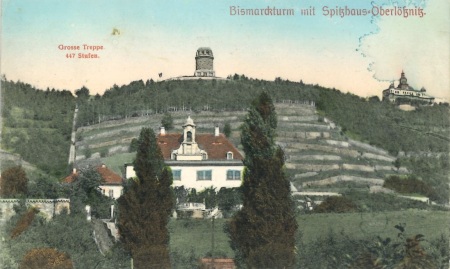100 years of the Hoflößnitz Wine Museum
which was officially opened on Whitsunday, 8 June 1924 under the name "Heimathaus", had a 15-year history and various fathers. At the large "Exhibition of the Lößnitz villages for crafts and trades, art, horticulture and industry" in May/June 1909 in Kötzschenbroda, the local branch of the Association for Saxon Folklore, led by Niederlößnitz headmaster Emanuel Erler, had organised a "special exhibition on the wine-growing era in Lößnitz". According to Erler, King Friedrich August III was so impressed by this exhibition during his visit "that he expressed the wish to the representatives of the authorities that this exhibition should be preserved." At the beginning of 1910, an informal "Hoflößnitz Committee" met in Lößnitz, which included state archivist Dr Woldemar Lippert. The committee's most urgent goal was to secure ownership of the historically valuable Lusthaus at Hoflößnitz, which was threatened by decay, and to establish a museum there where possible.
Both concerns were combined with the founding of the "Hof-Lößnitz Association" on 20 March 1912, to which Emanuel Erler and Dr Lippert, among others, belonged and which, thanks to the skilful fundraising of its first chairman Dr Friedrich Haase, was able to acquire the Hoflößnitz property and begin restoration work in the summer of 1912. The statutory purposes of the association
were the preservation of the castle with its valuable interior furnishings and the establishment of a "Museum of the History of the Lößnitz Villages and Saxon Viticulture". After the outbreak of the First World War, however, the association ran into financial difficulties and went bankrupt in 1915, bringing the museum project to a standstill for years - work on building up a collection had already begun in 1912. Nevertheless, the property had become the property of the association's main creditor, the municipality of Oberlößnitz.
In spring 1924, the municipality of Oberlößnitz appointed a four-member museum committee, which included two teachers from the local primary school, Oswald Neuparth and Bruno Stange, as well as the Saxon State Conservator Dr Walter Bachmann and, as chairman, the architect Dr Alfred Tischer. In mid-May 1924, the committee turned to the public with a request to donate "valuable Lößnitz antiquities" to the museum.
"valuable Lößnitz antiquities" to the museum. Within a very short space of time, four ground floor rooms in the Lusthaus were prepared for exhibition purposes so that the opening could take place just three weeks later under still very provisional conditions. At the beginning of December 1924, the local history museum held its first special exhibition as part of an art week with works by some well-known artists from all over Lößnitz, including Käthe Kuntze, Hans-Theo Richter, Georg Richter-Lößnitz, Karl Sinkwitz and Rudolph Wirth.
Inspired by the success of the museum's foundation, the Oberlößnitz spa administration initiated a second lavish project in 1924, a "Lößnitz Winegrowers' Festival" with a large parade from Hoflößnitz via Radebeul to Kötzschenbroda on 5 October. Once again, the museum director Dr Tischer was in charge; an initial meeting was held in Oberlößnitz just nine weeks before the date, on 1 August. The mayor of Oberlößnitz, Bruno Hörning, emphasised "that the winegrowers' festival should not be a special event for the municipality of Oberlößnitz, but a festival for the whole of Lößnitz, which should be supported by the joyful participation of all Lößnitz villages." The reason to celebrate was not least the now revitalised winegrowing industry in Lößnitz.
Despite the short preparation time, this festival, in which over 60 associations took part, was the event of the year and a great success, as can still be seen today in the film made during the event. Although Radebeul and Kötzschenbroda, as newly formed towns, each went their own way until further notice, their citizens and those of the then still independent neighbouring communities of Oberlößnitz and Wahnsdorf celebrated the winegrowers' festival from 3 to 6 October 1924 in perfect harmony. It would be 25 years until the next comparable festival. The 600th anniversary of the first documentary mention of Radebeul in 1349 was celebrated jointly by the whole of Radebeul in its current form in 1949.
The oldest museum in Radebeul, which will celebrate its 100th opening anniversary in 2024, has focussed entirely on the history of Saxon viticulture since the 1960s, in which the Hoflößnitz, once the wine estate of the Saxon electors and kings, itself played an important role. Located in the heart of the city and the Saxon wine-growing region, the Saxon Wine Museum, which has been run by the Hoflößnitz Foundation since 1998, keeps alive the memory of the industry that shaped the Lößnitz region for centuries before urbanisation began in the 19th century.
Frank Andert

© Stadtarchiv
Hoflößnitz früher